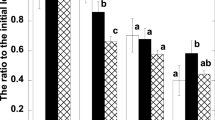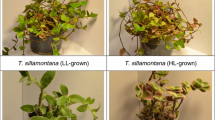Abstract
Alhagi sparsifolia Shap. is exposed to a high-irradiance environment as the main vegetation found in the forelands of the Taklamakan Desert. We investigated chlorophyll a fluorescence emission of A. sparsifolia seedlings grown under ambient (HL) and shade (LL) conditions. Our results indicated that the fluorescence intensity in the leaves was significantly higher for LL-grown plants than that under HL. High values of the maximum quantum yield of PSII for primary photochemistry (φPo) and the quantum yield that an electron moves further than QA - (φEo) in the plants under LL conditions suggested that the electron flow from QA - (primary quinone electron acceptors of PSII) to QB (secondary quinone acceptor of PSII) or QB - was enhanced at LL compared to natural HL conditions. The efficiency/probability with which an electron from the intersystem electron carriers was transferred to reduce end electron acceptors at the PSI acceptor side and the quantum yield for the reduction of end electron acceptors at the PSI acceptor side were opposite to φPo, and φEo. Thus, we concluded that the electron transport on the donor side of PSII was blocked under LL conditions, while acceptor side was inhibited at the HL conditions. The PSII activity of electron transport in the plants grown in shade was enhanced, while the energy transport from PSII to PSI was blocked compared to the plants grown at HL conditions. Furthermore, PSII activity under HL was seriously affected in midday, while the plants grown in shade enhanced their energy transport.
Similar content being viewed by others
Abbreviations
- ABS/RC:
-
average absorbed photon flux per PSII reaction center
- DIo/RC:
-
dissipated energy flux per PSII reaction center
- ETo/RC:
-
electron transport flux from QA to QB
- Fm :
-
maximal fluorescence yield of the dark-adapted state
- Fo :
-
minimal fluorescence yield of the dark-adapted state
- Fv :
-
variable fluorescence
- Fv/Fo :
-
potential activity of PSII
- HL:
-
ambient, high-light irradiance
- LL:
-
shade, low-light irradiance, 50% of ambient light
- PIabs :
-
performance index for energy conservation from photons absorbed by PSII antenna to the reduction of QB
- RC:
-
reaction center
- TRo/RC:
-
maximum trapped excitation flux per PSII reaction center
- Wk:
-
the ratio of variable fluorescence at the K-step to the fluorescence difference Fj-Fo
- φEo :
-
quantum yield of the electron transport flux from QA to QB
- φPo :
-
maximum quantum yield of primary PSII photochemistry
- φRo :
-
the quantum yield for the reduction of end electron acceptors at the PSI acceptor side
- ψEoEo:
-
the efficiency/probability that an electron moves further than QA-
- δRo :
-
efficiency with which an electron from QB is transferred to PSI acceptors
References
Ali N.A., Dewez D., Didur O., Popovic R.: Inhibition of photosystem II photochemistry by Cr is caused by the alteration of both D1 protein and oxygen evolving complex.–Photosynth. Res. 89: 81–87, 2006.
Bailey S., Walters R.G., Jansson S., Horton P.: Acclimation of Arabidopsis thaliana to the light environment: the existence of separate low light and high light responses.–Planta 213: 794–801, 2001.
Chen S., Yin C., Dai X. et al.: Action of tenuazonic acid, a natural phytotoxin, on photosystem II of spinach.–Environ. Exp. Bot. 62: 279–289, 2008.
Clijsters H., Van Assche F.: Inhibition of photosynthesis by heavy metals.–Photosynth. Res. 7: 31–40, 1985.
Govindjee: 63 years since Kautsky-chlorophyll-a fluorescence.–Aust. J. Plant Physiol. 22: 131–160, 1995.
Hagemeyer J.: Ecophysiology of plant growth under heavy metal stress.–In: Prasad M.N.V (ed.): Heavy Metal Stress in Plants. Pp. 201–222. Springer, Dordrecht 2004.
Jiang C.D., Wang X., Gao H.Y. et al.: Systemic regulation of leaf anatomical structure, photosynthetic performance, and highlight tolerance in sorghum.–Plant Physiol. 155: 1416–1424, 2011.
Kalaji H.M., Carpentier R., Allakhverdiev S.I., Bosa K.: Fluorescence parameters as early indicators of light stress in barley.–J. Photoch. Photobio. B 112: 1–6, 2012.
Lazár D.: Chlorophyll a fluorescence induction.–BBABioenergetics 1412: 1–28, 1999.
Lazár D.: The polyphasic chlorophyll a fluorescence rise measured under high intensity of exciting light.–Funct. Plant Biol. 33: 9–30, 2006.
Lazár D.: Parameters of photosynthetic energy partitioning.–J. Plant Physiol. 175: 131–147, 2015.
Li L., Li X.Y., Xu X.W. et al.: Assimilative branches and leaves of the desert plant Alhagi sparsifolia Shap. possesses a different adaptation mechanism to shade.–Plant Physiol. Bioch. 74: 239–245, 2014.
Lu C., Vonshak A.: Effects of salinity stress on photosystem II function in cyanobacterial Spirulina platensis cells.–Physiol. Plantarum 114: 405–413, 2002.
Ma Y., Wang X.Q., Zhang B. et al.: Effects of wind erosion and sand burial on water relations and photosynthesis in Alhagi sparsifolia in the southern edge of the Taklimakan Desert.–Chinese J. Plant Ecol. 38: 491–498, 2014.
Mehta P., Jajoo A., Mathur S., Bharti S.: Chlorophyll a luorescence study revealing effects of high salt stress on Photosystem II in wheat leaves.–Plant Physiol. Bioch. 48: 16–20, 2010.
Ohnishi N., Allakhverdiev S.I., Takahashi S. et al.: Two-step mechanism of photodamage to photosystem II: step 1 occurs at the oxygen-evolving complex and step 2 occurs at the photochemical reaction center.–Biochemistry 44: 8494–8499, 2005.
Perales-Vela H.V., González-Moreno S., Montes-Horcasitas C., Cañizares-Villanueva R.O.: Growth, photosynthetic and respiratory responses to sub-lethal copper concentrations in Scenedesmus incrassatulus (Chlorophyceae).–Chemosphere 67: 2274–2281, 2007.
Quiles M.J., López N.I.: Photoinhibition of photosystems I and II induced by exposure to high light intensity during oat plant growth: effects on the chloroplast NADH dehydrogenase complex.–Plant Sci. 166: 815–823, 2004.
Strasser R.: The grouping model of plant photosynthesis.–In: Akoyunoglou G. (ed.): Chloroplast Development. Pp. 513–524. Elsevier, Dordrecht 1987.
Strasser R.J., Srivastava A., Tsimilli-Michael M.: The fluorescence transient as a tool to characterize and screen photosynthetic samples.–In: Yunus M., Pathre U., Mohanty P. (ed.): Probing Photosynthesis: Mechanisms, Regulation and Adaptation. Pp. 445–483. Taylor and Francis Press, London 2000.
Strasser R.J., Srivastava A.G., Govindjee: Polyphasic chlorophyll a fluorescence transient in plants and cyanobacteria.–Photochem. Photobiol. 61: 32–42, 1995.
Strasser R.J., Tsimilli-Michael M., Qiang S., Goltsev V.: Simultaneous in vivo recording of prompt and delayed fluorescence and 820-nm reflection changes during drying and after rehydration of the resurrection plant Haberlea rhodopensis.–BBA-Bioenergetics 1797: 1313–1326, 2010.
Strasser R.J., Tsimilli-Michael M., Srivastava A.: Analysis of the chlorophyll a fluorescence transient.–In: Papageorgiou G.C., Govindjee (ed.): Chlorophyll a Fluorescence: A Signature of Photosynthesis. Advances in Photosynthesis and Respiration. Pp. 321–362. Springer, Dordrecht 2004.
Tsimilli-Michael M., Strasser R.J.: In vivo assessment of stress impact on plant’s vitality: applications in detecting and evaluating the beneficial role of mycorrhization on host plants.–In: Varma A. (ed.): Mycorrhiza. Pp. 679–703. Springer, Berlin Heidelberg 2008.
Wang G.G., Bauerle W.L., Mudder B.T.: Effects of light acclimation on the photosynthesis, growth, and biomass allocation in American chestnut (Castanea dentata) seedlings.–Forest Ecol. Manage. 226: 173–180, 2006.
Wang S., Zhang D., Pan X.: Effects of arsenic on growth and photosystem II (PSII) activity of Microcystis aeruginosa.–Ecotox. Environ. Safe. 84: 104–111, 2012.
Zhang D., Pan X., Mu G., Wang J.: Toxic effects of antimony on photosystem II of Synechocystis sp. as probed by in vivo chlorophyll fluorescence.–J. Appl. Phycol. 22: 479–488, 2010.
Author information
Authors and Affiliations
Corresponding author
Additional information
Acknowledgments: The work was financially supported by National Natural Science Foundation of China (No. 41571057; 41371516) and the Joint Funds of National Natural Science Foundation of China (U1203201).
Rights and permissions
About this article
Cite this article
Li, L., Li, X.Y., Zeng, F.J. et al. Chlorophyll a fluorescence of typical desert plant Alhagi sparsifolia Shap. at two light levels. Photosynthetica 54, 351–358 (2016). https://doi.org/10.1007/s11099-016-0195-9
Received:
Accepted:
Published:
Issue Date:
DOI: https://doi.org/10.1007/s11099-016-0195-9




